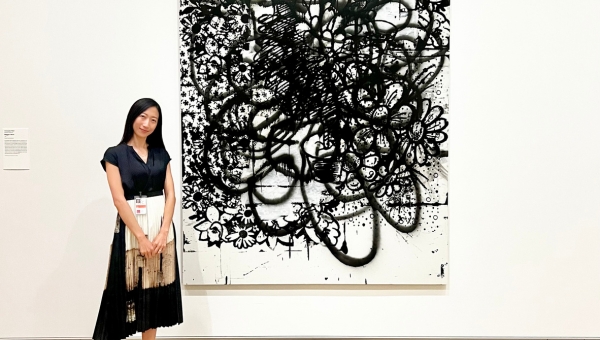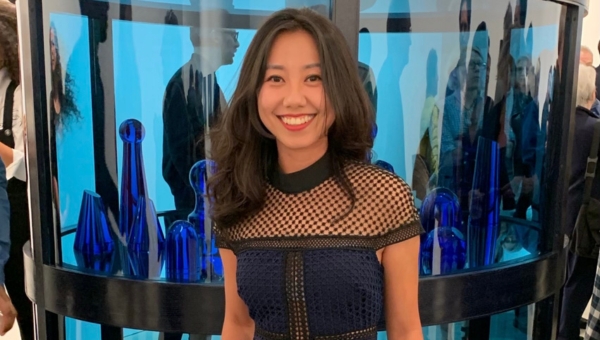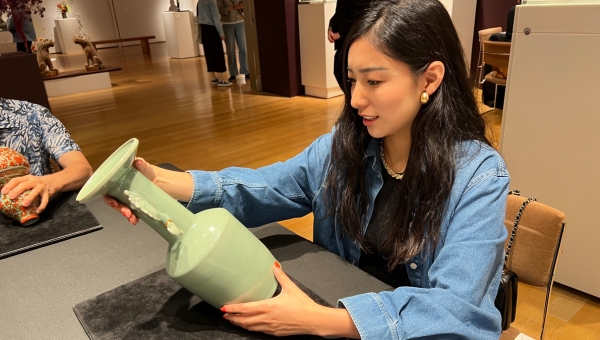From Galleries to Auction Houses, Alumni Make an Impact as Leaders in Visual Arts
By Emma Folts
After graduating from Heinz College’s Master of Arts Management (MAM) program, you may find yourself traveling all over the world to collect consignments of artwork for an auction house. You may work with renowned artists on exhibitions as the director of a growing gallery. Or you may develop programming for a nonprofit art society that enriches the local community.
The MAM program trains students not only for their first job after graduation but also for the more senior roles they may have later, said Program Director Jessica Bowser Acrie. The program’s interdisciplinary approach is unique among arts management programs. It provides students with a strong educational foundation in business, marketing, finance and leadership that supports them at for-profit galleries, nonprofit museums and more.
“Every single course you take, whether it be a core course or elective, is going to come with tools that you will have in your toolkit for your entire career,” Acrie said. “We are going to provide these business and technology-based skills that live and breathe in all of the classes at Carnegie Mellon University, and you are going to be able to capitalize on this knowledge.”
Along with the rigorous and varied curriculum of the MAM program, students take extracurricular trips to New York City and Washington, D.C., where they visit art and cultural institutions and network with the professionals working there.
MAM alumni go into a range of arts management roles. Three alumni shared their stories of how they’re able to impact the world of visual arts.
Providing programming and art to the Chicago community
Yi Cao (MAM ‘14) is the director of the Society for Contemporary Art (SCA) at The Art Institute of Chicago, where she manages a small team and helps develop artist programming and coordinate acquisitions. Throughout the year, she works with a programming committee to select and invite artists from around the world to speak at the Art Institute.
“I do a lot of research to find artists who fit our programming mission, as well as artists who are really up-and-coming but have not been given a platform,” Cao said. “Few contemporary artists ever get to exhibit at a major museum like the Art Institute, and those projects often take years to happen.”
She continued: “We feel like we are there to provide more artists the opportunity to gain exposure through artist talks at the Art Institute, which can be organized quickly and bring them directly to the public.”

Impact of the MAM Program
Yi Cao said she gained all of the skills necessary for her current role because her courses at Heinz College were so varied.
When selecting the speakers, Cao and the programming committee aim to feature artists who are from different backgrounds, who work in different mediums, and who are in varying stages of their career. Last season, SCA hosted a collective of three Indigenous artists called New Red Order, whose artwork addresses issues surrounding land ownership. Performance artist Regina José Galindo, from Guatemala, also delivered SCA’s first lecture in Spanish.
Cao works very closely with the speakers; she and the programming committee plan the lectures almost a year in advance. The committee seeks to ensure lectures are both educational and engaging, which requires Cao to understand not only the artist but also the nature of their work.
“If they paint or work with more traditional materials, it may be easier to show their work in a slideshow, but that may not work for artists who have video, installation and performance practices,” Cao said. “We've also paired speakers to be in a dialogue with other artists, as some are more reserved in presenting their work.”
The Society for Contemporary Art is affiliated with the Art Institute, but it’s an independent, member-based nonprofit, currently with more than 200 members. Each year, the members vote on artworks proposed by the SCA’s acquisition committee to be gifted to the Art Institute. So far, SCA has contributed more than 200 works to the museum’s collection in the nonprofit’s 85-year history.
Cao studied accounting as an undergraduate in Beijing, China, where she was born and raised. Though she was always interested in art, she didn’t know a career in arts or arts management would be viable. When she was looking for graduate programs, she realized she could combine her interest in art with her accounting and management background. So, she applied for Heinz College’s MAM program.
Initially, Cao thought she would pursue the performance track of the MAM program, as she had a background in music. Much of her first year in the program was spent exploring different career paths. Eventually, she got an internship at the Carnegie Museum of Art.
“That really helped me realize I have this deep interest in visual art and want to do more in the museum field,” she said. “After my internship there, I was hired upon graduation, and I spent five years there.”
The MAM program is designed for future leaders, Cao said. When she began her role as director of the Society for Contemporary Art, she realized she had gained all of the skills necessary for the role because her courses at Heinz College were so varied. The program also taught Cao both soft and hard skills, which she said was particularly helpful to her as an international student.
“I enjoy my current role very much. I think contemporary art, especially, addresses a lot of today's issues,” she said. “I think seeing the world through an artist's lens is incredibly valuable.”
Managing a growing gallery
Yvonne Zhou (MAM ‘14) always loved visual art –– she studied painting as a child. Now, she’s the director of Karma, a gallery focused on contemporary art that has locations in New York City and Los Angeles. Zhou works with artists on their gallery and museum exhibitions, and she helps art collectors build their collections. If the gallery has an exhibition on view, she assists art collectors in purchasing pieces. She travels frequently, often to meet with artists and art collectors.
Impact of the MAM Program
Yvonne Zhou said the discipline and hard work required to succeed in the MAM program has supported her in her current role.
While enrolled in the MAM program, she attended a networking event in New York City. There, Zhou visited a gallery she had connected with before her graduate studies began. That summer, she traveled with the gallery to Hong Kong for an art fair. The gallery later helped Zhou land a job after graduation at the James Cohan Gallery in New York, where she worked for about seven years.
Along with networking opportunities, Heinz College offers a rigorous academic environment, Zhou said, adding that the discipline and hard work required to succeed in the program has supported her in her current role. She recommends MAM students try out different career paths to understand what they’d like to pursue. Before her first gallery job, she interned at auction houses, museums, and galleries, and she learned what suits her.
Through these experiences, Zhou developed an appreciation for the ways art can affect people.
“Everyone can experience art. Artists inspire us, spark new ideas, and help open our minds, inviting us to see and feel the world in new and meaningful ways,” Zhou said.
Working in the fast-paced world of auction houses
For five years, Clementine Chen (MAM ‘13) was the senior consignment director at Heritage Auctions, billed as the world’s largest auction house. In that role, she sought to solicit consignments – in which the owner provides artwork to the auction house for it to be sold –– and put together sales. She’d travel nearly 50 times a year.“Usually, in the morning, I would have around 50 emails waiting for me from people all over the world, saying, for example, ‘My mom's decided to downsize, and she has all these art pieces. Could you please tell me whether it’s worthwhile for me to sell?’” Chen said. “Every now and then we would find very valuable items from those emails.”

Impact of the MAM Program
Clementine Chen valued the MAM program’s courses related to gallery management, databases and marketing.
“I’m not suited for the typical nine-to-five job,” Chen explained. “An auction house job is the type of job where you talk to different people every day, you see new things every day. That excites me a lot. I think that's the best part of my job. Also, it’s the place where you can have hands-on experience with amazing artwork on a daily basis. That's an experience you probably can't get anywhere else.”
All of Chen’s subsequent internships were related to auction houses or Asian art. Shortly after she graduated, she moved to California and began working for Clars Auctions. She gradually moved up the corporate ladder, and she sold a set of Chinese paintings that broke the company record for the most expensive piece ever sold. Around that time, she learned Heritage Auctions had opened a satellite office in San Francisco and made the switch.
About two years ago, Chen decided it was time to start her own business, a move that would allow her to have greater flexibility. She founded Kanzan Art Advisor, and she helps museums and institutions build their art collections. She also is the senior consultant for business development at Clars Auctions.
Chen valued the MAM program’s courses related to gallery management, databases and marketing. She recommends students make use of the college’s Mary Beth and Miles Reidy Career Center, and she stresses the importance of networking. Chen earned her job at Heritage Auctions not long after she attended a reception and asked why the auction house didn’t have an Asian art specialist, she said. As it turned out, the auction house was looking for one.
“Don't be shy to connect with people who graduated more than 10 years ago, or professors you think might know the people you want to know. Most of the time, they are happy to help,” Chen said.